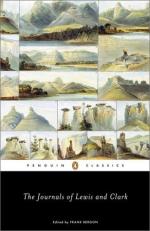|
This section contains 3,907 words (approx. 14 pages at 300 words per page) |

|
SOURCE: “Wilderness Aesthetics,” in American Literary History, Vol. 9, No. 1, Spring, 1997, pp. 128-61.
In the following essay, Bergon considers the Lewis and Clark journals as characteristic of early American nature writing.
The Lewis and Clark expedition, like the adventures in the Epic of Gilgamesh and the Odyssey, was a trek into an unfamiliar and often frightening wilderness—the first, longest, and largest of nineteenth-century US government expeditions into terra incognita. Launched from St. Louis in 1804 in a 55-foot masted keelboat and two pirogues carrying more than 8,000 pounds of food and equipment, the Voyage of Discovery, as it was called, lasted two years, four months, and ten days. Round-trip, it covered 7,689 miles between the mouth of the Missouri River and the Pacific outlet of the Columbia River. To a young nation—the US was barely 17 years old at the time—Lewis and Clark brought back maps of previously uncharted rivers...
|
This section contains 3,907 words (approx. 14 pages at 300 words per page) |

|


